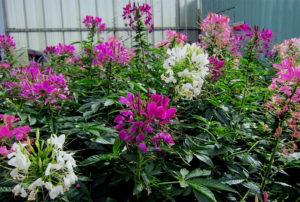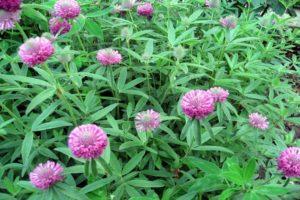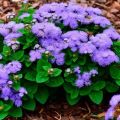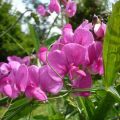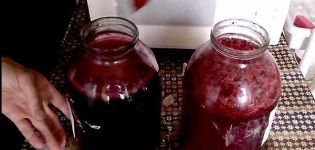Planting and caring for Scylla in the open field, description of species and varieties
Scylla, she's a scrub, is a fragile and delicate flower that, without waiting for all the snow to melt, breaks out of the soil. This small but bright flower can be found not only in the forest, but also in the flower beds of gardeners. Scylla is quite simple to plant and take care of her in the future. For this, many flower lovers appreciate it.
Description and features
Scylla belongs to the Asparagus genus, but earlier she was introduced to the Hyacinths or Liliaceae. This is a perennial bulbous flower, there are no less than 95 species of it. The main natural habitats of the flower are European countries, Asia and Africa. Scylla is found on flat and mountainous terrain, in deciduous and deciduous forests, as well as in steppe regions.
The root system of the flower is a round or slightly elongated bulb. On top of the onion there are scales of several shades, it depends on the type of plant.
The foliage is long, growing directly from the root. The foliage is lanceolate or linear, with parallel veins. The average height of the culture is 15-20 cm. The inflorescence consists of 3-15 flowers, depending on the variety.
Scylla has a distinctive feature, during rain or cool weather, all the foliage is pressed to the ground, and in warm weather, the leaves are almost vertical. They also have high winter hardiness and adapt well to any soils and areas.
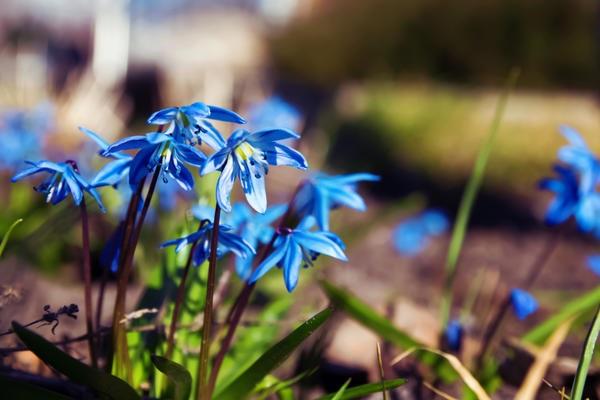
Outdoor cultivation
You don't need any special skills or knowledge to grow a Scylla, but nevertheless, some recommendations should be followed.
Seat selection
The best place for flowers is in sunny areas or areas with moderate shade. For example, it can be planted between garden trees.
Soil preparation
Scylla is an unpretentious culture, so it can develop both on loamy soil and on sandy soil, but does not like high acidity and marshy environment. A soil rich in organic matter is preferred.
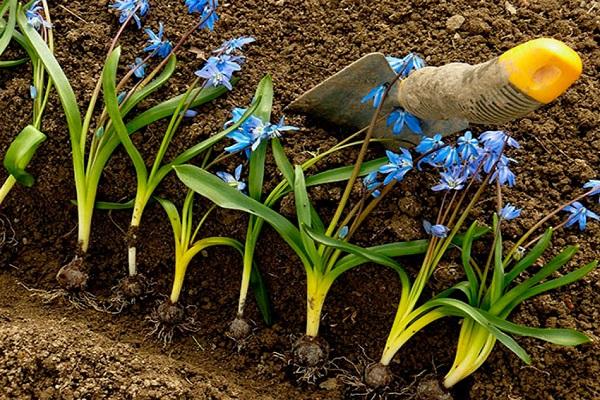
Before planting woodlands on the selected area, you need to dig it up and add peat or humus. In addition, it is recommended to add forest soil with pieces of bark and foliage to the soil.
Landing scheme
Planting in the soil is carried out in late June or early July. At this time, the leaves on the adult representatives are already yellowed and begin to die off.
It is necessary to dig holes about 7 cm deep at a distance of 5-10 cm from each other and plant the shoots.
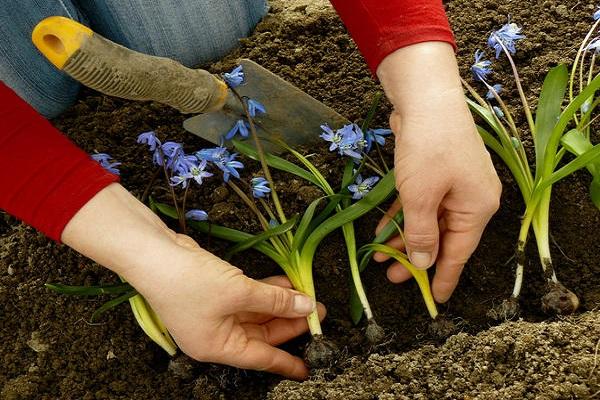
Care
In order for the Scylla to grow and develop, it needs care. It is necessary to water it in a timely manner, feed it and remove weeds, weeding and loosening the soil around the plants.
Watering
Watering woodlands is carried out in the morning. And you need to irrigate so that drops of water do not fall on the flowers, otherwise they may lose their attractive appearance. Watering should not be too plentiful, since Scylla still loves not wet soil, but moist one.
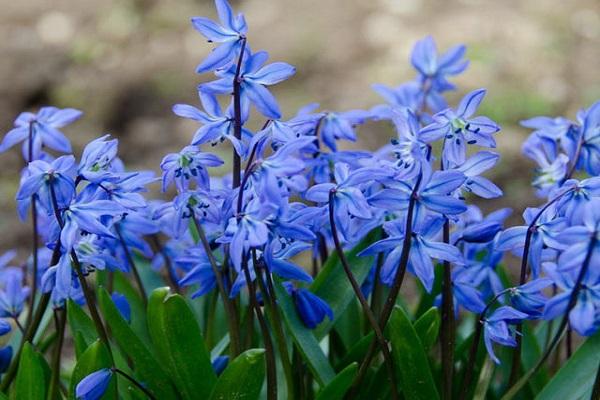
Top dressing
Some Scylla varieties bloom in the spring, while others in the fall, feed the plants before they bloom. For this, mineral dressings are used:
- potash;
- phosphoric;
- nitrogen;
- with magnesium;
- with iron.
In the autumn, it is better to give preference to granular preparations or those that dissolve slowly. And in the spring, liquid forms of fertilizers are used.
They also feed the woodlands with complex dressings, such as "Nitrofoska". After dressing, flowering is more abundant and longer. Plants develop correctly and survive the winter well.
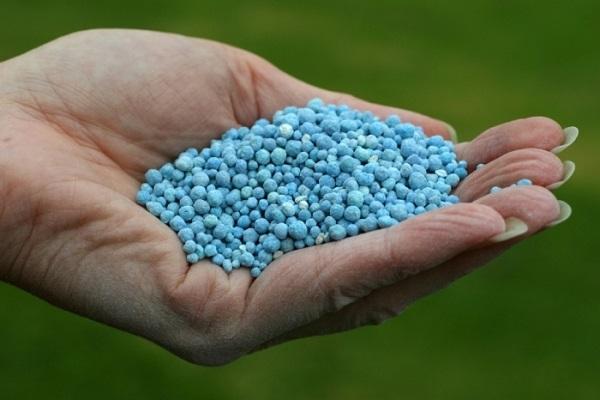
Weeding and loosening
It is recommended to loosen the soil after each watering. The loosening depth should be about 2-2.5 cm, since the root system of the woodland needs oxygen. Weeds should also be removed regularly. They inhibit scilla growth and can spread diseases and pests.
Removal of testes
If you do not pay attention to the flowers, removing the testes, then after a few years they will occupy a significant area of the site, multiplying by self-seeding.
Testes bolls ripen around the end of June. They turn yellow and begin to crack. Until the moment of cracking, such boxes should be removed.
Transfer
The scrub is transplanted every three years. It is necessary for healthy growth and support of the decorative properties of plants. They are removed from the ground, the babies are separated from the bulbs and transplanted. The most successful time for such manipulations: late September - early October.

Reproduction
These flowers can be propagated in two ways: seeds and daughter bulbs.
Bulbs
Such reproduction takes place during the transplantation of bushes, when the daughter bulbs are separated and transplanted separately. One adult bulb produces about 4 baby onions.
Seeds
Seeds are poured out of the ripened testes and sown into the ground. Scylla seed germination is not very high, so it is better to sow them immediately after harvest.
To increase germination, some gardeners use growth stimulants by treating seeds with them. The material should be sown no deeper than 8 cm.And the distance between each seed should be about 2 cm.
The flowering of grown plants from seeds will come no earlier than in 2-3 years.

Diseases and pests
Most often, scrub, like other crops with small root bulbs, suffer from bulb rot, gray rot and a disease called achelenchoides.
Gray rot
It develops on the foliage of flowers and on the top of the bulb. Because of this, the plants become covered with gray fluff, and the process of decay begins. Then spots form on the bulb, the green of the flower turns yellow, and the flower dies.
Diseased plants are removed from the soil and destroyed. Otherwise, the disease can spread and develop on other plants.
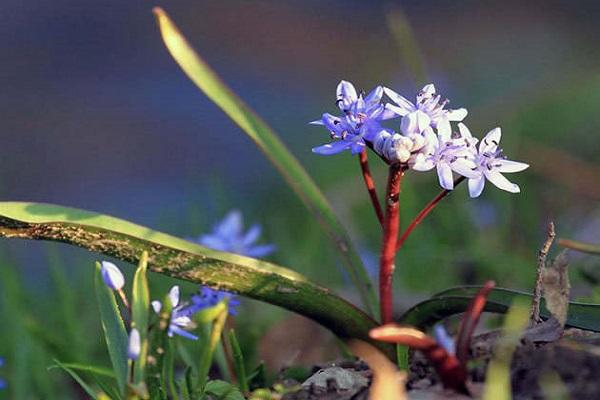
Achelenhoides
This disease manifests itself in ring rot, which is clearly visible when the bulbs are cut. The ground part of the flower is affected, becoming covered with necrotic spots. The scales begin to turn brown, after which rotting begins. Affected specimens lose their attractiveness and begin to lag behind in development.
Bulb rot
This disease is caused by some fungal infections. It all starts with yellowing of the foliage, then red spots form on the onion. During the conservation period, the onions harden and die. The disease occurs with excessively high humidity.
And of the pests, the most terrible are rodents. Meadow mites and other parasites are less common.
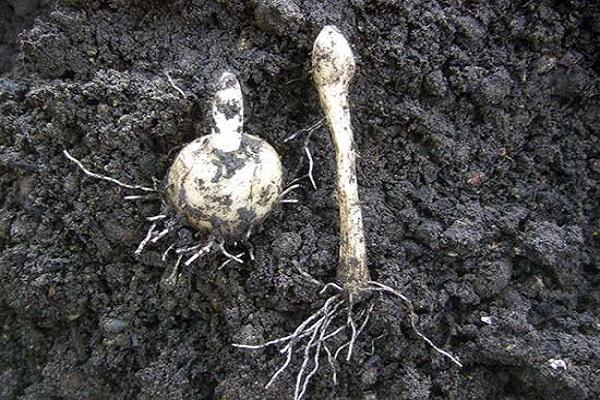
Rodents
House and meadow mice, as well as voles, feed on the bulbs of the scilla, and in the spring they eat up the sprouts. In order to ward off rodents from the plants, a shallow groove is made around the plantings. Poison is poured into it and a little sprinkled with earth so that the birds do not get poisoned.
Meadow tick
The parasite and its larvae grind the bottom of the scilla bulbs. Once inside, they drink the juice of the internal scales of the onion. Because of this, the onions begin to rot and the plants die. In order to get rid of this mite, you should use insecticides. Suitable "Akarin", "Aktellik", "Agravertin". As a preventive measure, gardeners pickle onions even before planting.
Kinds
Scylla is divided into several types.
Bell-shaped
It is considered one of the most attractive types of woodland. It is a short flower 20-30 cm high. It has one flowering shoot with bluish, white and pink flowers, similar to bells. They are collected in bunches of 5-10 flowers. The flowering cycle begins in the last month of spring and lasts half a month. Before winter, such varieties are dug up or made for them a shelter.
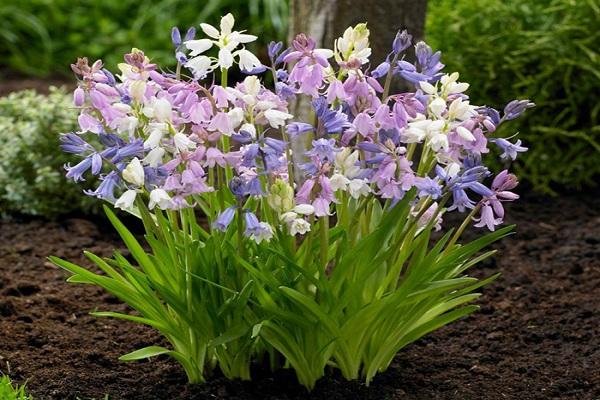
Double-leaved
It is also called two years old. The species of this scilla is considered one of the smallest, namely up to 15 cm. The two-leaved scrub blooms profusely.
The plant has 1-3 shoots, bunches of flowers with a bright, pleasant smell come out on them. Each flowering shoot grows about 15 flowers, they are white or pink.
This species has only two leaves, their length is 20 cm. Thanks to this, the species got its name. These spines begin to bloom from the end of April and bloom for about 2 weeks.
Autumn
On the plants, 5 flowering shoots are formed, on which flowers are of light purple or red-purple tones, combined into separate brushes. Each inflorescence has 6 to 20 flowers. Blossom in late July or early August. Do not grow above 15-20 cm.The length of the narrowed sheets is up to 25 cm.
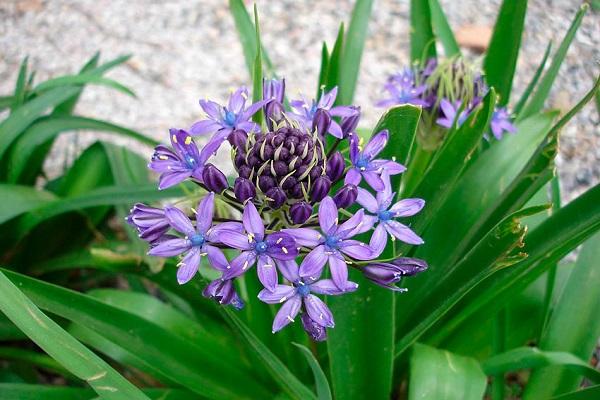
Peruvian
Bushes no more than 35 cm. It has 2-3 flowering sprouts, on which small flowers of a rich blue color are formed. Their diameter does not exceed 1 cm. The inflorescences of these scyllas are dense, forming a conical shape. Their number reaches 85 flowers on one flowering sprout.
Leaves are linear, about 30 cm long and 1.5 cm wide. On one representative of the Peruvian scilla, there can be from 5 to 8 of them.
Siberian
The species got this name due to an error. It was described by living plants, they were grown from seeds. In the description of the new species, it was indicated that the described culture grows in Siberia. The species was given the name Siberian Scylla, and later it turned out that this flower does not grow in Siberia, and the seeds that were studied were collected near Tsaritsyn (now Volgograd).
In this species, foliage and inflorescences break through at the same time. Siberian woodlands bloom in blue or white. In spring they form "carpets" of densely growing flowers. The flowering period lasts about 3 weeks.
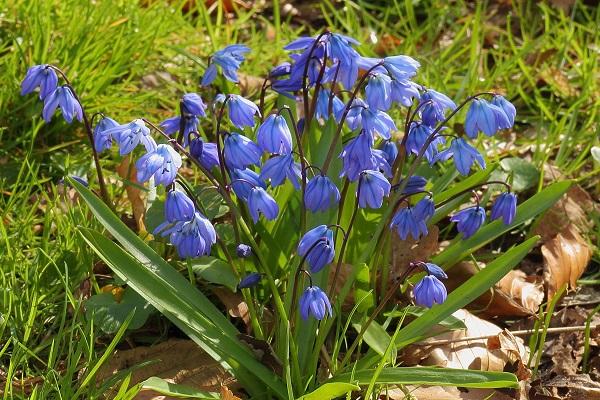
This species has a peculiarity that lies in its special sensitivity to sunlight. Flowers clearly "wake up" at 10 am, opening their petals, and close at 5 pm. In cloudy or rainy weather, they may not open at all.
Popular varieties
Each species of woodland has several varieties, here are the most popular ones.
Rose Queen
Inflorescences are pink with a lilac tint, with a slightly noticeable pleasant aroma. Bushes grow no higher than 20 cm.
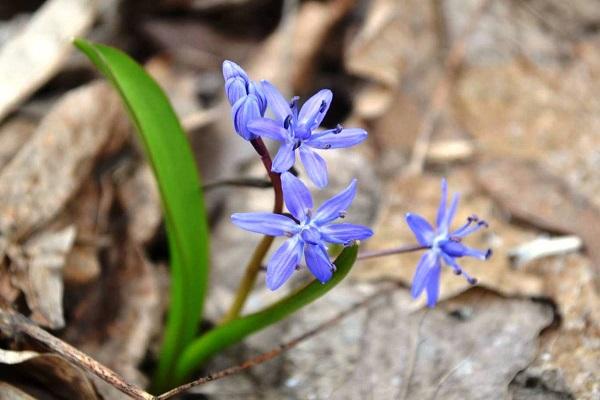
Sky Blue
They have strong stems, on which large bluish flowers with dark stripes are spiral-shaped.
La Grandes
It is a variety of bell-shaped woodland and has white flowers. There are up to 15 of them in each inflorescence.
Rosabella
It grows up to 30 cm. It blooms with lilac-pink flowers, united in dense raceme-like inflorescences.The variety is endowed with a pleasant smell, which intensifies with the onset of the evening.
Excelsior
Belongs to the bell-shaped species. The variety has 3-7 basal leaves, the length of which is from 20 to 30 cm. There is one flowering sprout, with the same height. The flowers are blue, united in inflorescences with flowers of about 1.5-2 cm. It blooms in May for 20 days.
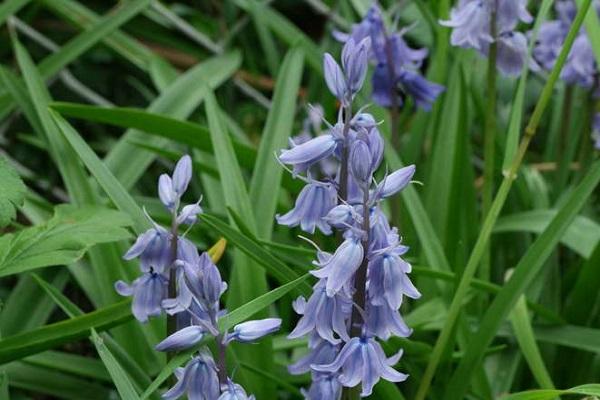
Blue Queen
Also referred to as the bell-shaped scilla. A fairly common variety, whose height is about 20 cm. It has blue inflorescences, in which there are up to 10 flowers.
Blue Giant
In this variety, the inflorescences have a blue tint, which darkens over time.
Blue Pearl
It grows 20 cm in height. Forms up to 15 flowers in one flowering sprout.
Dainty Made
Flowers of this variety have a delicate lilac color. It grows up to 30 cm.
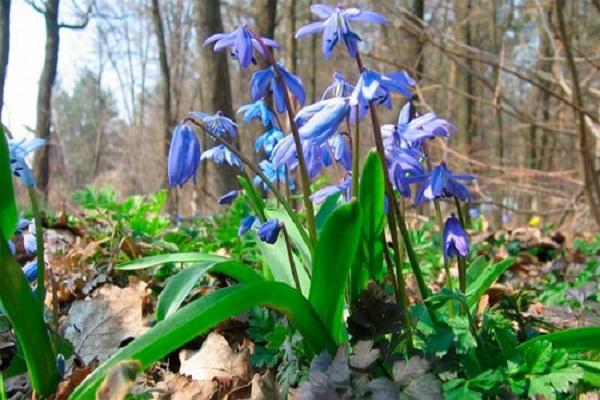
Queen of pinks
These spines bloom in dense pink flowers with a faint but attractive scent. Height 15-20 cm.
Mount everest
The inflorescences of this Scylla variety are quite tall, with white flowers.
Myosotis
This representative of Asparagus has blue inflorescences. They are formed on low flowering shoots.
Spring Beauty
The flowers of this variety are 3 cm in size. They are collected in bunches of 6 lilac inflorescences. Does not form seeds, but it is easy to grow with daughter bulbs.
Alba
This variety belongs to the species of Siberian woodlands. It grows up to 15 cm. Albs are white, consist of 6 petals, their size is 3 cm. It has a pleasant scent.
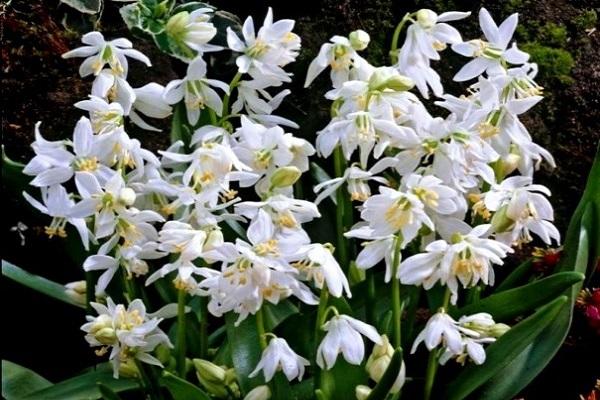
After flowering
After the cessation of flowering, the shoot is cut off. The foliage is removed only after its complete withering away. Species practically do not need special preparation for winter, because they are frost-resistant. Their root system easily tolerates winter frosts. But still, plants that are planted in open areas are best covered with spruce branches or dry foliage.
This flower is one of the first to meet early warmth after a cold winter, therefore it is a symbol of spring. Scylla is a gentle, unpretentious plant with bright flowering. It does not take much time to leave, so gardeners are increasingly planting it in their plots.
